Back in 2009, I reviewed Luzine Happel’s book, Basic Principles of Schwalm Whitework, which, in my mind, is still The Definitive Guide on Schwalm whitework embroidery.
Since then, Luzine has written quite a few books that have been translated into English, some of which I’ve reviewed – like Fancy Hems, a book on Early Schwalm Whitework, a beautiful pattern book for Schwalm embroidery, and books on filling techniques. Really, when it comes to this type of whitework embroidery and all the nuances of it – all the “sub techniques” that can be applied to other types of embroidery, too – Luzine is a goldmine of information!
Her latest books are of the sampler variety, in a sense. Here’s a look at both of them: Openwork Pattern Samplers and Openwork Needleweaving Patterns.
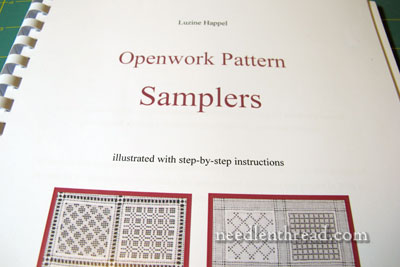
Openwork Pattern Samplers by Luzine Happel is a book dedicated to creating – from start to finish – samplers of openwork fillings, which are used not only in Schwalm whitework embroidery, but also in a variety of whitework and needlelace techniques.
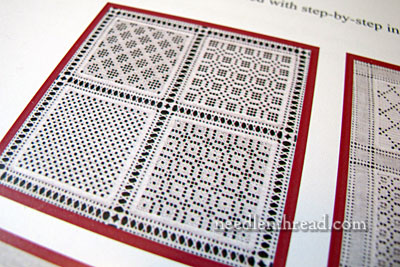
The cover features four four-square small samplers, which are worked out in the book. Each of the samplers is edged differently, and each sampler contains four squares that are filled differently.
With these types of filling techniques, the “ground” on which the filling is worked is actually the linen fabric. It is not a pre-made net, made separately from the linen (as is seen, for example, in filet lace). Threads are removed from the linen and worked into a grid, and then the fillings are worked on the resulting grid of linen fabric threads.
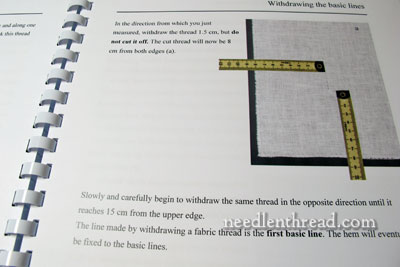
Luzine shows the embroiderer how to measure accurately to establish the boundaries of the sampler, …
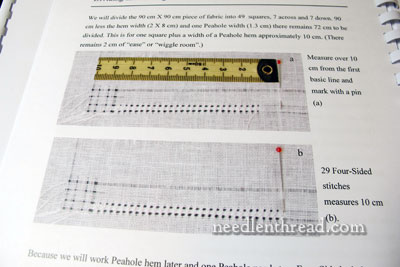
… taking the stitcher through every step in the whole layout and preparation of the ground fabric.
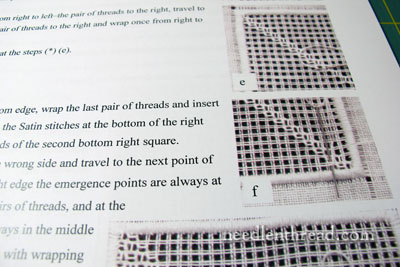
She then demonstrates the various fillings, step by step. She talks about starting and ending threads, where to start, how to gauge the filling across the square to get everything to work out just right.
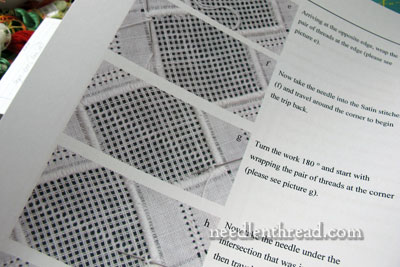
Her step-by-step photos are clear, and the explanations are easy to follow.
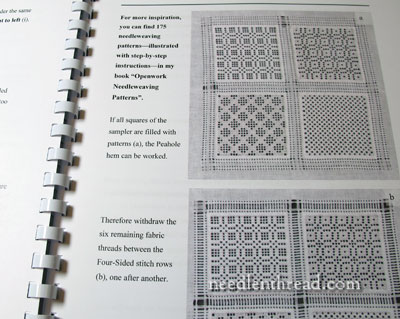
With the fillings complete, it’s time to move on to the question of finishing, which includes the fancy thread work around each square…
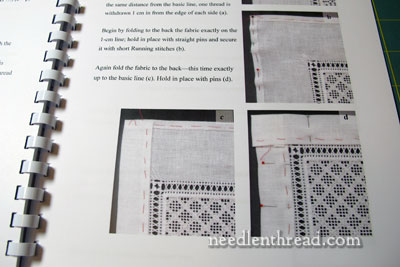
…as well as hemming techniques.
In the book, Luzine offers instructions for several different approaches to samplers: there are four four-square samplers with different edging treatments, as well as instructions for two different table runners, and instructions for one checkerboard sampler. She covers exactly what materials are needed for the techniques involved, and everything else you need to know to work any of the sampler projects.
Openwork Pattern Samplers is just a fantastic book, when it comes to instruction! If you are keen to learn how these lacy fillings are created, if you love whitework of any type, if you are an avid “sampler” who likes the challenging of sampling various techniques and learning them through working samplers – you will love this book!
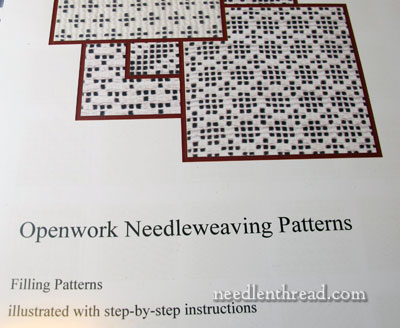
Openwork Needleweaving Patterns is a book that works in conjunction with Openwork Pattern Samplers and in conjunction with Basic Principles of Schwalm Whitework.
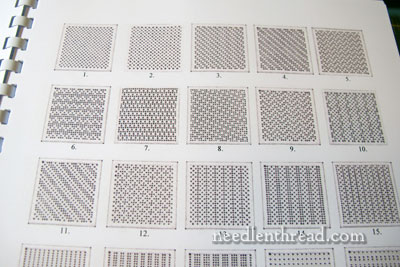
Once you open the book, you’ll know exactly what’s within! The contents are laid out in a fascinating grid over the first five pages of the book – a grid of tiny squares, each illustrating a different filling pattern.
How many filling patterns?
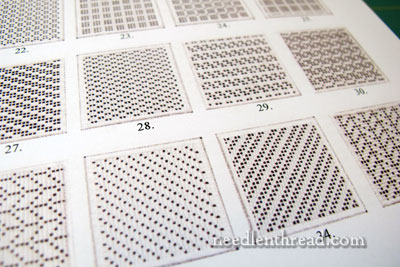
Lots…
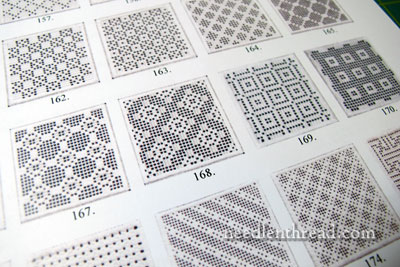
…and lots! 175 filling patterns, to be exact!
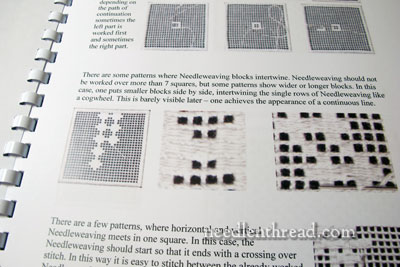
The instruction in the book begins with the basics of needlewoven fillings.
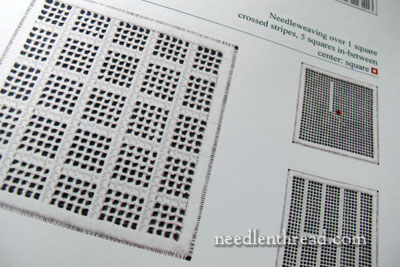
And the rest of the book is dedicated to each of the 175 filling patterns. The pattern is shown enlarged, with photos to demonstrate starting points and the method of filling to achieve the pattern.
While Open Needleweaving Patterns can work as a stand-alone book, throughout the book, there are references to Basic Principles of Schwalm Whitework, so it’s nice to have that book on hand for reference.
The combination of Openwork Pattern Samplers and Open Needleweaving Patterns is a formidable one! I think you could occupy your whole stitching life working unique combination samplers from them!
Luzine’s books are self-published, printed in color on quality paper, with plastic outer covers, and bound with a comb (which makes them easy to use while stitching).
You can find all of Luzine’s excellent books on her website. While you’re there, don’t miss the section under “Luzine Happel” titled “My Home.” It is a gallery of gorgeous photos of her home and surrounding area of Eschwege, which is about 55 miles from the center of the Schwalm region of Germany. I could get lost there.
And don’t miss the photos of her sampler, either! You’ll never quite think the same way about a sampler again. It’s… Big. And beautiful!
The books, though, are in Luzine’s shop – they are available in German, French, and English (make sure you select the right option!). She accepts Paypal for payment, and her shipping is super quick. I normally receive books from her within about four business days from placing the order. (And I’m in Kansas…)
A note: don’t forget to work out the currency conversion, depending on where you are located. Shipping is quite reasonable, but the exchange rate does make a difference in the price. While the books may seem somewhat expensive by today’s Bulk Amazon standard, they are worth every penny. You won’t find instruction this thorough on these techniques anywhere else!







Hi Mary,
I love Luzine’s books and I have every single one of them! They are a must-have for white-work embroiderers.
Thanks for bringing them to the attention of a wider public. Luzine deserves it!
Have a nice weekend, Jessica
Oh Mary, these books look so beautiful! I just love counted whitework like this and these books are definitely going on my wishlist. Thank you for reviewing these books and bringing them to our attention.
Kathryn 🙂
Thank you for bringing these books to my attention. I’m fascinated by them! I am putting them on my wish list to add to my stitching library.
Mary, these books look wonderful! I shall be adding them to my wish list. I’ve recently become enamoured of whitework, and look forward to learning more. Thank you.
Thanks so much for writing about these books! I have taken classes in drawn thread work and net darning for making baby dresses. Elements of the samplers you showed would be great embellishments for the bodice of a baby dress or linen blouse.
I just ordered 3 of Luzine’s books. Have held off for months but today’s post from you was the push I needed. Thanks!
Dear Mary
This really looks an interesting book and so many step by step photos I was thinking of whitework for my next project so this would be a great reference, the book is certainly going on my wishlist which is getting longer every time you write a book review ha ha! thanks for sharing this with us.
Regards Anita Simmance
I have her first book, and it is awesome! So many pictures, and step by step directions – perfect for me. I know the book itself helped me to make my first sample of Whitework ‘wonderful’! I may have had a little bit to do with it 🙂 but without the excellent instruction, I think it would have been much different. I think I need to catch up – there are two empty spaces on my bookshelf! 🙂
G’day Mary,
The home town photos are wonderful, thank you…but the dog in the water, it’s incredible. It’s the 5th last photo (middle, 2nd last row). If you didn’t see it you must have another look!
Luzine’s work and books are very special and am glad to be reminded of them again.
Cheers, Kath
Perhaps I should add that the whole water shape is like a dog’s head and just part of it’s body. The branched out sections at the top are it’s ears, the middle 2 stones (I guess that’s what they are that the water is rushing over and making 2 dark places) are it’s eyes and the bottom stone it’s nose. The movement of the water between the stones is defining it’s snout.
I sent the page to rellies, titled ‘The Wet Dog’, and they took me literally. Like, what wet dog? We must have the wrong picture…